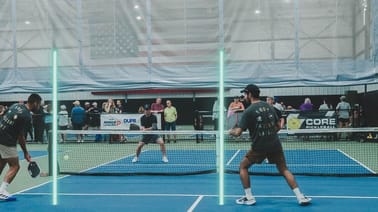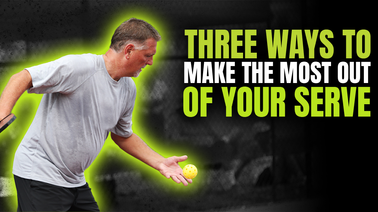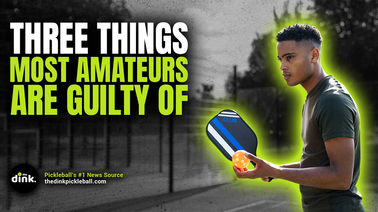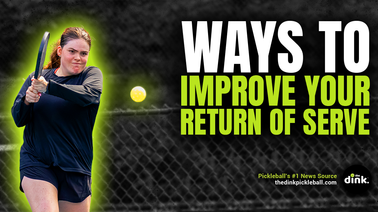
If you are struggling to score points in pickleball, there’s a good chance your struggles are a direct result of your baseline play.
Getting to the kitchen is crucial, especially as you increase in level/rating. How you approach and execute shots from the baseline is everything, and will result in successful transition forward and therefore more points on the scoreboard.
Let’s review the three main plays from the baseline and when to use them.

Play No. 1: The Drop
The third shot drop is arguably the hardest shot in pickleball to master but also the most important. You should be dropping the third (all things considered) around 70 percent of the time, if not more.
At its worst, a high, floaty drop that your opponents can demolish is still better than a drive that sails 20 feet long or wide. Even the worst in-play drop can give you a chance to win the point, and at the very least keeps you alive for one more ball in the rally.
When should I hit the third-shot drop?
To reiterate, this should be your bread and butter play from the baseline. Unless your opponents can’t handle even a mediocre drive, you should be dropping anywhere from 70-100 percent of the time on your third shot. When hit effectively, the drop can be offensive and give your partner a chance to poach in the middle. And again, even when hit poorly, it will keep you alive in the point.
The one absolute killer mistake that you want to avoid is missing a drop in the net. Your opponent won’t even have a chance to miss if you do this, and it ends the point immediately.
The third shot drop is also foolproof against almost any return. If your opponent whacks a powerful return that lands deep, it’s a good decision to hit a safe drop that keeps you alive. If they hit a weak return that lands short and low, running up and hitting a safe drop that allows you to transition to the kitchen is the right play.
The only time you might correctly need to hit the drive is if your opponent’s return sits up high in the midcourt (see more on this below).
Remember that dropping cross-court or to the middle is a safer option than dropping down the line. Not only is the net lower, but it will take longer to reach your opponents, giving you time to take a few steps forward and also set up for the next shot. Dropping down the line also exposes you to a potential erne, and takes away your time to start transitioning forward.
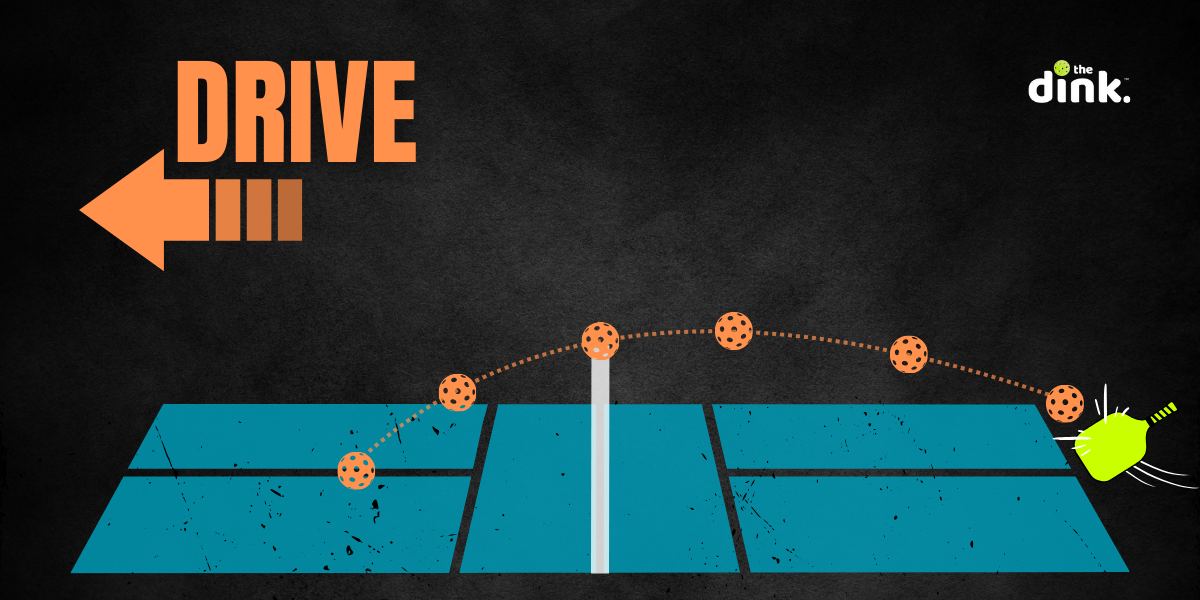
Play No. 2: The Drive
So much of pickleball decision making is situational and contextual. There is no better example of this than deciding when and how often to hit a third-shot drive.
Unlike the drop, the drive is typically a bit riskier, and is more often used at the beginner and pro levels, since it might be the most natural shot to carry over from tennis or other racket sports. The drive is a great chance to win points quickly, apply pressure to your opponents, and give your partner a chance to get to the kitchen and poach.
When should I hit the third-shot drive?
If your bread and butter is the drop, then the drive is a nice change of pace on the third shot. Again, context is everything in pickleball. If you discover early in a tournament or rec game that one (or both) of your opponents struggles to volley off a drive, then by all means use it as frequently as possible until they figure out a way to stop it.
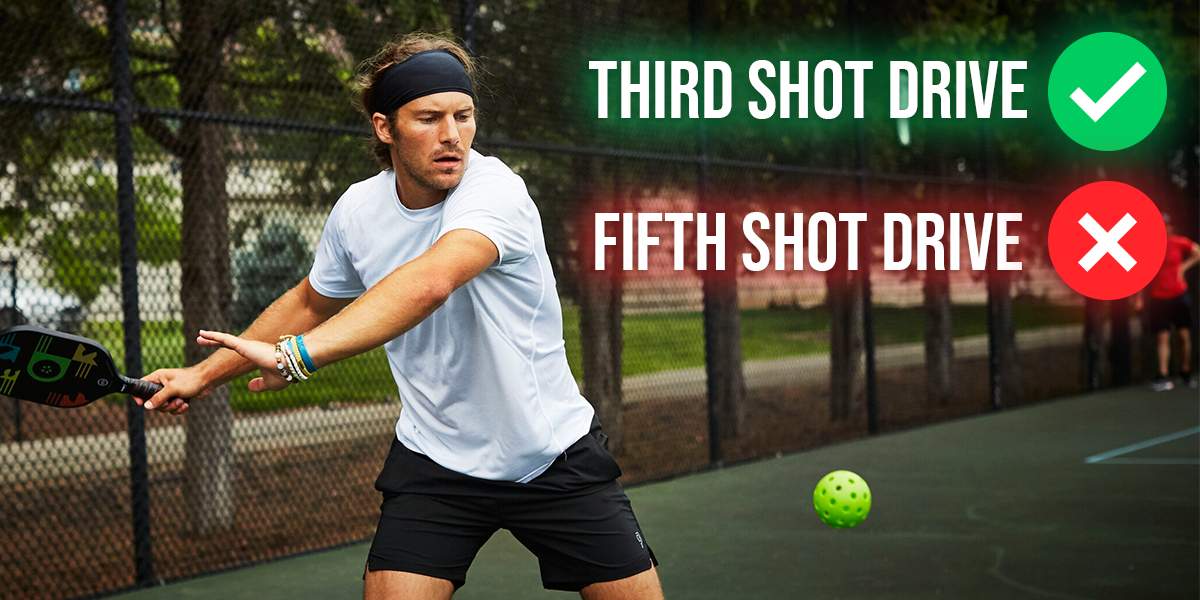
If you or your partner can hit a low, unattackable drive on every single third shot, then again, bombs away! Otherwise, you should be relying on dropping the majority of your thirds, and sprinkling the drive in situationally.
One of those situations is when your opponents hit a weaker return. If you can identify that their return is sitting up high in the middle of the court, this is a great opportunity to hit a drive. Conversely, if they hit a very good deep return to the middle of the court and you are unable or uncomfortable trying to execute a drop for some reason, then hitting a nice, safe drive is a great option. Context is everything.
One final thought about driving the third – remember the golden rule: if you drive the third, almost 100 percent of the time you should drop the next ball. One mistake so many beginner and intermediate players make is trying to drive the fifth and even seventh shots. Once your opponent gets your third shot drive back, make the smart decision and drop the fifth and transition to the kitchen.

Play No. 3: The Lob
The idea of hitting a lob on the third shot was probably unheard of as little as 2-3 years ago, but bear with me on this one. With the improvement in paddle technology, players are able to generate more spin on every single shot, including the lob.
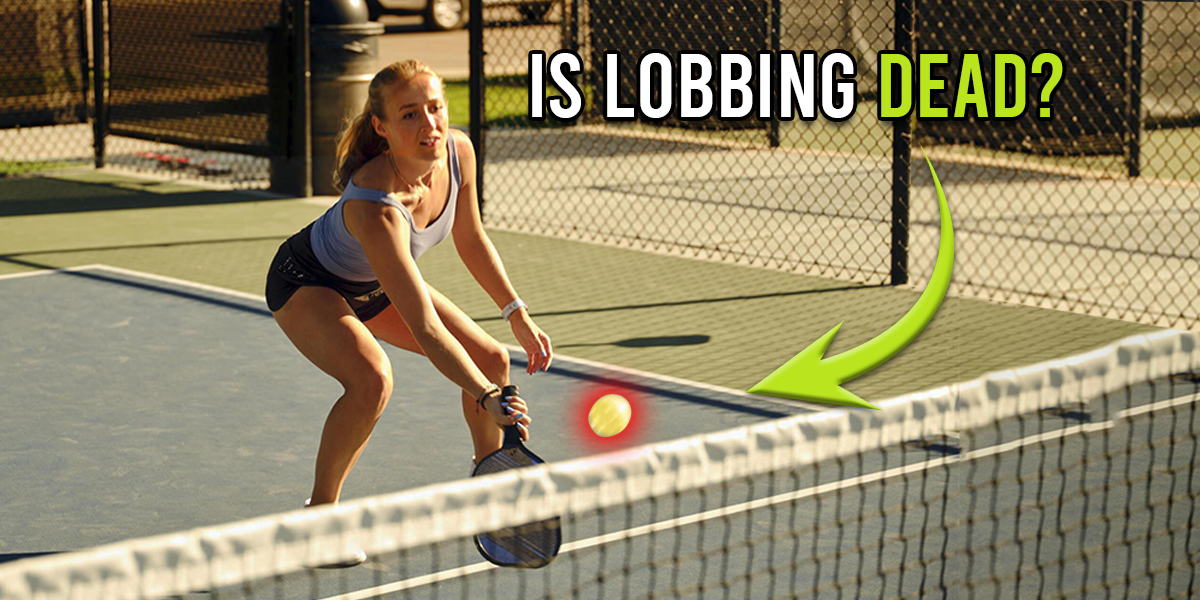
Now, I listed this shot as third for a reason. This should be used extremely sparingly and the context of when to use it is more important for this shot than the drop or the drive. Let’s keep this shot tucked away in the shot toolbelt under the "once in a while" category.
When should I hit the third-shot lob?
While it may be used sparingly, it doesn’t mean this shot can’t be used effectively when it is employed. If your opponents hit a very good return that puts you or your partner off balance for the third shot, throwing up a deep, high lob is not a bad play.
If we know one thing about this sport, it’s that it is extremely difficult to put the ball away or hit a winner in doubles at any level. Players lack the ability to hit with enough power or angle to put a deep lob away.
Throwing up a lob, especially off of a really good return, is a great way to stay alive at the start of a point, and will give your opponents a chance to miss the overhead. Or, maybe they hit an overhead that is not as good as their return, and you get an easier look at hitting a drive or a drop on the fifth shot. Simply put, throwing up a deep, high lob is no longer as difficult or as frowned upon as it once was.
Again, context is key here. One other thing to consider is the sun. Often times one side of the court will have a team starting straight into the sun (especially when looking up). Hitting a lob can be twice as effective when this is the case, and may even result in your opponents backing off the kitchen line to retrieve the lob at an easier position off the bounce.
With a little help from Mother Nature, your lob on the third shot can go from defensive to offensive. Play the game, don’t let it play you.
Recommended Drill: Third shot drop variety
Now that you know the three main plays from the baseline, it’s time to practice them.
Get with your practice partner(s) and have them line up at the kitchen line opposite of you (either down the line or cross-court). You will stand at the baseline and they will replicate a return with their feed. Start by hitting a drop, then on the next ball hit a drive, and then a lob. Rotate through these three shots, working on moving your feet to get in position. Start by alternating each shot, and then add in patterns like two drops, one drive, one lob, etc.
The goal is to be able to make 10-20 different shots in a row without missing and without letting your opponent attack you too much. Play this drill down both lines and both cross-court angles.
Bonus Tip: A little spin goes a long way
If you are at the point where you are trying to incorporate more spin into your shots (dinks, drives, serve, etc.) remember that a little spin goes a long way.
Too often players try to overdo it with spin, and they end up using way too much wrist or change their grip way too much. Keep a continental grip, and add just a little more of a flick or slice (if underspin) at the contact point. Right when you are making contact with the ball, brush up the back or cut under the ball subtly.
Too much, and the ball won’t hit your paddle cleanly and you will mishit the ball. Remember to always have a short backswing, and that the point of contact is when the spin should be applied.
Enjoy the grind, and remember, you can’t dink all day if you don’t start in the morning.

Eric Roddy
Eric is a PPA tour pro living in Charlotte, NC, sponsored by PROXR. In addition to playing PPA events, he teaches pickleball 2-3 hours a week, enjoys golf, and listening to his favorite band Goose.



